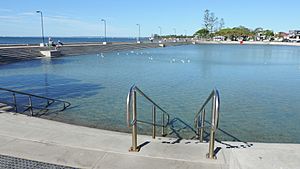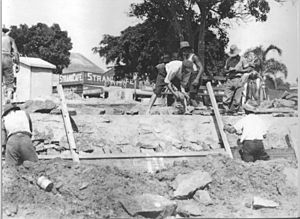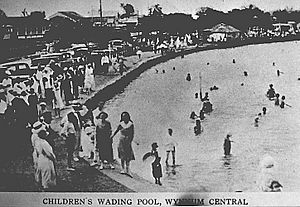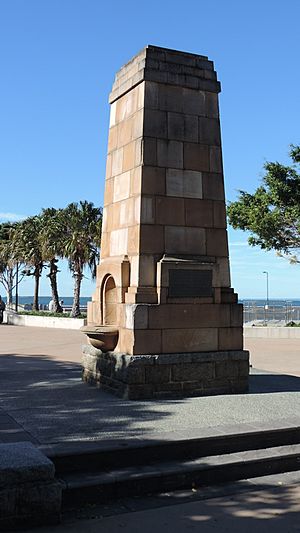Wynnum Wading Pool facts for kids
Quick facts for kids Wynnum Wading Pool |
|
|---|---|

Wynnum Wading Pool with Moreton Bay beyond, 2014
|
|
| Location | The Esplanade, Wynnum, City of Brisbane, Queensland, Australia |
| Design period | 1919–1930s (interwar period) |
| Built | 1932–1932 |
| Official name: Wynnum Wading Pool Reserve, Manly Wading Pool | |
| Type | state heritage (built) |
| Designated | 5 October 1998 |
| Reference no. | 602040 |
| Significant period | 1932 (fabric) 1932–ongoing (social) |
| Significant components | trees/plantings, swimming pool, memorial – fountain, jetty/pier |
| Lua error in Module:Location_map at line 420: attempt to index field 'wikibase' (a nil value). | |
The Wynnum Wading Pool is a special swimming spot located right on the edge of Moreton Bay in Wynnum, Queensland, Australia. It's a large, shallow, oval-shaped pool that fills up with ocean water when the tide comes in.
This amazing pool was built in 1932 by people who were looking for work during a tough time called the Great Depression. It officially opened in 1933 and has been a popular place for swimming and fun ever since. Because of its history and unique design, it's listed on the Queensland Heritage Register, which means it's an important part of Queensland's past. It's also sometimes called the Manly Wading Pool or Wynnum Wading Pool Reserve.
Contents
A Look Back: The Pool's History
The Wynnum Wading Pool Reserve was created in 1932. It's a shallow pool with concrete walls and a sandy bottom, designed to fill with the ocean's tide.
How Wynnum Became a Popular Spot
The Wynnum and Manly areas first saw European settlers in the 1860s. Soon, people started visiting for holidays, building homes along the beautiful bay. In 1882, land was sold for the Manly Beach Estate, named after a famous beach in Sydney.
When the Cleveland railway line was finished in 1889, it made it even easier for people to visit. By the late 1920s, you could get to Wynnum by train, bus, or car, making it a very popular holiday spot and a great place for families to live.
Before the wading pool was built, people swam in the sea or in pools attached to jetties. Even though Moreton Bay's waters were calmer than open beaches, people were still worried about sharks and jellyfish. Special enclosed swimming areas were already popular in other places like Sandgate.
Building the Pool During Tough Times
In 1922, a local leader named Alderman J. Patterson suggested a plan to create a recreational area, including a pool, by using sand from Wynnum Creek.
The 1930s brought the Great Depression, a time when many people couldn't find jobs. To help, the Queensland Government started a program to fund public projects and give work to unemployed people. The government paid the workers' wages, and the local council provided the building materials. People who received unemployment benefits, sometimes called "The Susso", were given work based on their family needs. For example, a man with a wife and one child might work three days a week.
The Brisbane City Council used this program to build the Wynnum Wading Pool Reserve and other projects in the area, like the Manly Retaining Wall.
How the Pool Was Built
Construction of the wading pool began in 1932. Workers reclaimed land from the sea and built a concrete wall. This wall created a barrier between the pool and Moreton Bay, and also made a nice walkway along the foreshore.
The pool fills up with water through three pipes in the wall when the tide is high. Then, special gates are closed to keep the water in when the tide goes out. This process happens every two weeks, and the pool's sandy bottom is cleaned at the same time.
The pool is about 128 meters long and 54 meters wide. It's quite shallow, with a maximum depth of about 75 centimeters, making it perfect for wading and playing. It has a sandy bottom, five shallow steps on three sides, a concrete ramp for easy access, and even a slippery slide!
Hundreds of people came to the official opening on January 21, 1933. They watched a sailing event and enjoyed the new pool. Soon after, floodlights were installed, allowing people to swim and enjoy the pool even on hot nights.
The pool itself hasn't changed much since it was first built. However, the area around it has been updated to include change rooms, barbecue spots, and a white sandy beach called Pandanus Beach. The pool has been loved by both locals and visitors since 1932. It's used by swimmers in summer and by model boat fans in winter.
On July 13, 2008, the wading pool was reopened after a big upgrade that cost A$6.5 million.
What the Pool Looks Like Today
The Wynnum Wading Pool Reserve is part of a lovely park area along Moreton Bay. To the north of the pool, you'll find the Wynnum jetty. There are barbecue areas at both ends of the pool. The northern end has been updated with showers, change rooms, toilets, a play area, and the beautiful Pandanus Beach.
Trees like pines, bauhinia, and figs are planted along the foreshore and around the pool. You'll also see a special sandstone drinking fountain at the northern end. This fountain is a memorial to Walter Barnes, who was a local politician for the Wynnum area.
The pool is a large oval shape, measuring about 128 meters by 54 meters. Its deepest point is around 75 centimeters. A narrow concrete path separates it from the bay. The pool has a natural clay base covered with fresh sand every two weeks. There are five shallow steps around most of its edges, a concrete ramp for easy entry, and a slippery slide at the northern end. You'll also find two signs showing the water depth.
The pool is filled with salt water that comes in through three concrete pipes during high tide. These pipes have mesh screens to stop sea creatures from entering the pool.
Why the Wynnum Wading Pool is Special
The Wynnum Wading Pool Reserve was added to the Queensland Heritage Register on October 5, 1998, for several important reasons:
- It shows Queensland's history: The pool is a great example of how the government helped people find work during the Great Depression in the 1930s. It was built as part of a program to create jobs for the unemployed.
- It's a rare example of its kind: This type of tidal wading pool, built with this technology, is quite rare in Queensland.
- It's beautiful: The pool is also important because of its lovely surroundings and its location right next to Moreton Bay.
- It's important to the community: Many local people and visitors have enjoyed the Wynnum Wading Pool for generations. It has a strong connection with many community groups and is valued for its social history and as a fun park complex.
See also




